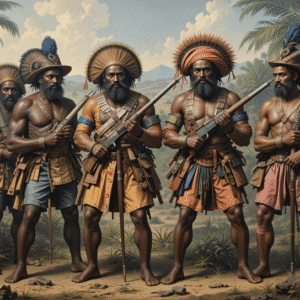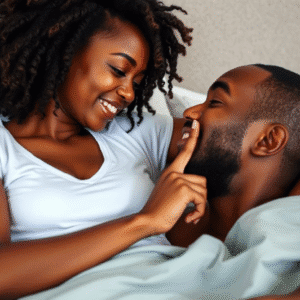The Maroons: Jamaica’s First Freedom Fighters
The Maroons: Jamaica’s First Freedom Fighters – Or as Mi Granny Say, “Di People Who Seh ‘Mi Nah Bow!’
By: Di Yard Culture Watcher – Serving Culture Hot Like Jerk Pan on a Friday

Ask any Jamaican who the Maroons are, and you’ll probably get one of three answers:
- “Mi did hear bout dem inna school, dem people weh run weh go live inna di bush.”
- “Dem deh inna Accompong, right? Mi cousin seh di festival nice!”
- “Maroons? Oh! Di same one dem weh seh dem nah tek chat from nobody!”
And all three are technically correct. But there’s more to the Maroon story than bush life, boiled yam, and annual drumming. These weren’t just “people weh love bruk out inna di hills” — these were Jamaica’s original freedom fighters, rebel kings and queens who told the British: “Unuh can gwaan wid unuh ‘white man law’ — mi follow mi own drumbeat.”
So sit back, grab a piece of roast breadfruit, and let’s dig into the tale of the Maroons — a story full of rebellion, resistance, and more bush tactics than a National Geographic special.
Who Were the Maroons?
Long before TikTok, toll roads, and dutty December, Jamaica was a plantation island where enslaved Africans were brought by force and expected to work like “duppy slave fi eternity.”
But not everybody tek to that lifestyle. Some Africans, the bold ones, said:
“Mi nah live like no mule. Mi a free man — mi nah mek no buckra man mash mi spirit.”
So what did they do? They escaped. They ran up into the mountains — rugged places like the Cockpit Country where even goats think twice before trotting. There, they built whole communities — with farms, laws, and “real order — not no ‘massa seh’ foolishness.”
These runaway warriors became known as the Maroons, and to this day, if you visit their towns, you’ll feel like you’ve stepped into a different version of Jamaica — one with more history per square foot than your great-uncle’s living room wall full of “old-time picture weh turn sepia colour.”
The Original Guerrilla Warriors
The British, in all their powdered-wig glory, didn’t like the idea of runaway slaves setting up their own villages and — worse — raiding plantations and freeing other slaves.
But the Maroons weren’t easy pickings. They were skilled in guerrilla warfare. I mean, these people moved through the jungle like breeze — barefoot, quiet, and “fast like how yuh granny lock di pot when unexpected visitor come.”
The British army — in their stiff uniforms and poor tropical tolerance — tried and failed repeatedly to conquer the Maroons. The Maroons said:
“Unuh haffi come better dan dat. Di bush is mi bedroom, di hill is mi pillow, and mi spirit nuh bow fi no red coat.”
Eventually, after too many losses, the British waved the white flag and signed peace treaties — in some cases even paying the Maroons to stop raiding and instead help keep order. A bold move, considering these were the same folks who had said:
“Mi nah follow no white man law.”
Queen Nanny: The O.G. of Resistance
Now if we’re talking Maroons and not bringing up Nanny of the Maroons, “we might as well tun off di light an’ pack up.”
Queen Nanny wasn’t just a leader — she was legend. Said to have supernatural powers (like catching bullets in her buttocks and flinging dem back — no joke), Nanny led her people with strategy and sass. She used terrain, knowledge, and spiritual power to outwit and outfight the British.
Even today, ask a Maroon elder and they’ll tell you:
“Nanny neva did tek talk. She was a woman of action — a real lioness.”
She’s one of Jamaica’s seven National Heroes, and probably the only one who could still clap a spirit back into its body if it ever crossed her.
Maroon Towns Today: Legacy with a Side of Festival
Today, you can still visit places like Accompong in St. Elizabeth and Moore Town in Portland — living Maroon communities where the traditions are still strong.
Go during the annual January 6 celebration and you’ll hear drums, see processions, taste traditional food, and probably hear someone shouting:
“Dis ya is fi wi ancestors — wi nuh forget weh wi come from!”
And you better behave yourself while you’re there, because Maroons have their own laws. It’s not a joke — “inna dem town, dem run dem business different. Nuh come wid yuh Kingston law and expect applause.”
So Why Does It Still Matter?
The Maroons didn’t just run from slavery — they created freedom. They didn’t ask for permission to be free. They declared it. Fought for it. Lived it. Protected it like granny guard har Sunday cake from di pickney dem.
In a time when identity and resistance are buzzwords, the Maroons were doing it long before hashtags. Their legacy is about:
- Standing firm in the face of oppression
- Preserving culture despite pressure
- Choosing dignity over survival
Or in plain Jamaican:
“Dem did nah bow. Dem did know demself. Dem did bun Babylon from long time.”
The Maroons weren’t perfect — some say their treaties were too cozy with the British, and yes, there are debates. But make no mistake: They were trailblazers. Freedom fighters. “Di first set a people fi seh ‘nah mek slavery define mi destiny.’”
Their story isn’t just history. It’s inspiration. A reminder that even in the darkest times, there are always those brave enough to say:
“Mi nah wait fi freedom. Mi ago fight fi it, live it, and pass it down like a good family name.”
So next time yuh hear di word “Maroon,” don’t just think bush and drums. Think strategy. Think legacy. Think rebellion with rhythm.
And as mi granny would put it:
“Dem did no joke ting — dem did real warriors. Whole heap a people free today cause dem did seh, ‘Mi nah bow fi nobody.’”
Stay tuned for more culture, more laughs, and more truth wid a likkle pepper sauce. Mi gone.




